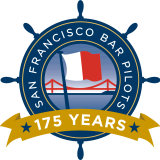Oversight and Licensing
Demanding Work in Challenging Waters
The San Francisco Bar Pilots protect our waterways, marine life, shoreline, and economic vitality through the critical public service we provide. Conditions on the water are frequently hazardous and often come with dense fog, strong winds, and dangerous currents amidst high concentrations of vessel traffic in constrained areas.
State and Federal Oversight
To ensure that Pilots are prepared for this physically and mentally challenging work, there are strict state and federal regulations that govern the selection, training, licensing, and ongoing professional development of all San Francisco Bar Pilots.
The importance of state regulated pilotage was acknowledged in regulations passed during the first session of the United States Congress in 1789. California followed suit in 1850 during its first legislative session by establishing the California Board of Pilot Commissioners to oversee the selection, training, and licensing of San Francisco Bar Pilots.

Board of Pilot Commissioners Licensing Overview
State licensed pilots hold key positions in the safe passage of shipborne commerce in the waters under the Board’s jurisdiction. They must exemplify the highest standards of leadership, professionalism, and personal integrity. Mariners selected for the Pilotage Training Program must demonstrate that they are fully capable of meeting the demands of accountability and responsibility associated with such positions. The vital role of pilots trained appropriately in safe navigation upon our waters cannot be overemphasized. The Board adheres to equal opportunity precepts when selecting applicants to participate in the Pilot Trainee Training Program.

Training Program
Through a transparent, objective, and competitive examination process, the Board of Pilot Commissioners periodically selects trainees who meet the experience and federal licensing criteria established by state law. Successful candidates are placed on a list in ranked order based on exam results and experience. The BOPC determines when individuals from this list are offered a position as a pilot trainee when openings become available in the training program.
Candidates interested in becoming a San Francisco Bar Pilot should submit an application to the California Board of Pilot Commissioners. The Commission administers the application, testing, selection, training, and licensing processes.
California State Pilot Training Program
Pilot trainees work under the supervision of the San Francisco Bar Pilot Evaluation Committee and Board of Pilot Commissioners. Each trainee is required to successfully navigate every type of vessel to and from every facility multiple times. This rigorous training results in a trainee piloting a minimum of 300 ships. The duration of the training program is up to 36 months and not all candidates successfully complete it. Therefore, there is no guarantee that a state license will be issued at the conclusion of the program.
The Pilot Evaluation Committee (PEC) tracks each trainee’s progress and, based on a specific set of criteria, makes recommendations to the Board of Pilot Commissioners regarding trainee status and completion of regulatory requirements. Upon a trainee’s successful completion of the training program, the PEC provides its recommendation to the Board for the issuance of a certificate of completion. Once a trainee has passed the requisite physical examination by a Board physician, and the Board has determined that the maximum number of licensed pilots has not been reached, it may issue the trainee a license as a San Francisco Bar Pilot.
Ongoing Professional Training
The Board of Pilot Commissioners requires every licensed pilot to participate in a continuing professional development program. There are two forms of training that every pilot must complete every five years:
Combination Course:
Bridge Resource Management for Pilots
Simulator Based Ship Handling, including emergency maneuvering and ship handling in close quarters
Emergency Medical Response
Advanced Electronic Navigation Systems
The Hazards of Fatigue and Effective Strategies to Prevent Fatigue while on Duty
Radar Navigation in Low Visibility in Restricted Waters
State and Federal Regulatory Review
Manned Scale Model Ship-handling Course:
Training on scale model ships provides a realistic experience with the maneuvering characteristics of the type of commercial vessels that routinely transit the waters in the pilotage area. Training is conducted on a controlled lake facility that replicates conditions that are found on the San Francisco Bay. Using these models, pilots may safely and effectively practice challenging ship handling maneuvers and emergency situations that may not be encountered in routine pilotage.


